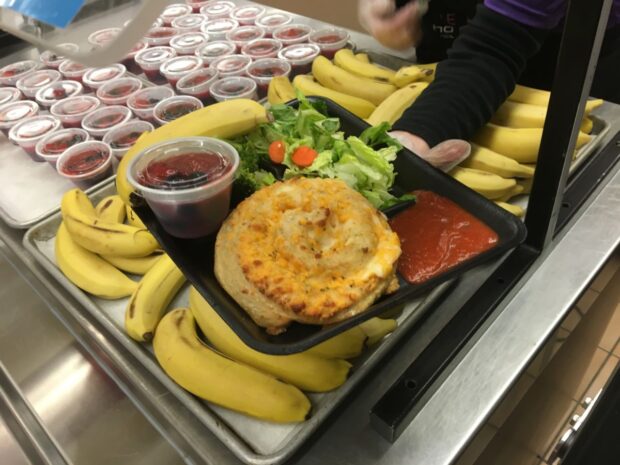It’s noon at Shelley High School and senior Landon Holtz hasn’t touched his fruits or vegetables.
“The cooked carrots are gross,” he says, prodding the steaming, orange mound on his lunch tray with a fork. “And the pears are stiff.”
Holtz stuffs his mouth with some french fries, downs some chocolate milk and a hotdog drizzled in ketchup — then heads for the trash can to dump the rest of his lunch.
Idaho educators have long grappled with food waste in public schools. It’s difficult to gauge how much is tossed out each year, but one recent study suggests that Idaho schools waste millions of dollars worth of uneaten food.

Administrators and school lunch personnel say several factors contribute to the waste. It’s difficult to project how many kids will eat school lunch on any given day. Meanwhile, federal requirements stipulate that students take a minimum number of fruits or vegetables, even if kids say they won’t eat them.
School lunch laws also strap meals with stringent sodium and sugar restrictions that leave some kitchen workers scrambling to deliver meals comparable in taste to the unhealthier foods many kids opt for outside school.
“We used to be able to cook things here the way we would for all our kids at home,” said Hillcrest High School kitchen manager Natalie Parkinson. “But all that changed with all these guidelines.”
Federal guidelines promote healthy eating but contribute to waste
The State Department of Education doesn’t collect food-waste data, but a recent study in one of Idaho’s largest school districts revealed that 30 percent of the food it serves ends up in the trash. At that rate, Bonneville School District students threw out about $248,000 worth of food served during the 2014-15 school year. A 30 percent rate among all of Idaho’s school districts would peg food waste at $6.6 million.
“It’s disheartening, I know,” said Heather Plain, food service coordinator in the Bonneville School District.
The study puts Bonneville on par with worldwide food-waste rates, which also hover around 30 percent. School districts in other parts of the country have reported waste rates of up to 40 percent.
Current federal requirements promote healthier school meals but also contribute to the waste. In 2012, the USDA implemented new nutritional standards for school meals. Mandated by the Healthy, Hunger-Free Kids Act of 2010, the standards slash acceptable amounts of sugar and sodium, while simultaneously raising the required amount of whole grains, fruits and vegetables made available to students.
The law also stipulates that students take at least one serving of either fruits or vegetables during meals — a good idea for promoting health, but not so effective at curbing food waste.
“You’ll see some kids take the fruit or vegetables, put it on their tray, walk right over to the trash and throw it away,” Plain said.
The number of students who eat school lunch on any given day fluctuates, also contributing to the problem. While elementary educators often take a morning tally of students opting for school lunch, middle schools and high schools sometimes rely on guesswork, or cook food on the spot.
Letting kids choose reduces food waste
Plain and other food experts say many students have acclimated to the 2012 guidelines, reducing waste in the process.
State food officials heard plenty of complaints over the changes early on, but such concerns have since died down, said SDE child nutrition director Colleen Asumendi.
“More recently, we have heard schools say students are starting to eat these foods now that they are more familiar with seeing them,” Asumendi said.
Which makes sense, since some research suggests that prolonged exposure to unfamiliar foods eventually triggers consumption. But simply waiting for students to acclimate to unfamiliar food isn’t enough, local experts say.
Many Idaho school districts — including Shelley and Bonneville — opt for an “offer versus serve” approach. Rather than having food slabbed onto their trays, kids get to choose at least three items, including one mandatory serving of fruits or vegetables. Kids can take all available food items if they want.
“When all these items are put on students plates and kids don’t have a say, food waste starts to go through the roof because more of it goes uneaten,” Plain said. “But kids usually know what they want and won’t waste as much if they get to choose.”
More districts are also moving toward a “true-cycle” menu approach, which enables lunch personnel to rotate their most popular meals every four weeks. Knowing which meals are coming up allows students to determine earlier on whether or not they’ll have hot lunch on any given day. Meanwhile, lunch managers track the amount of food served, and readjust how much to cook when meals roll around again.
Plain also reports a reduction in food waste when elementary schools hold recess before lunch, enabling kids to work up their appetites before swarming the cafeteria. Swapping lunch and recess has resulted in up to two fewer garbage bags full of waste at one Bonneville elementary school, Plain said.
But some food waste is inevitable. Hillcrest kitchen workers recently tossed 13 slices of unserved pizza — not bad when you’re serving 350 kids, said kitchen manager Natalie Parkinson.
Though Plain said she doesn’t like to see any food thrown out, she discourages her managers from relying on charitable organizations, such as nearby food banks, to finish off uneaten meals. Such “noble” efforts are sometimes met with restrictions over reheating previously prepared food. Reliance on food banks can also create justifications for cooking too much food, Plain said.
